Preventive Care
Preventing tooth decay with regular checkups
Tooth decay is caused by sugars left in your mouth that turn into an acid, which can break down your teeth. Children are at high risk for tooth decay for a simple reason: Many children and adolescents do not practice regular, good oral hygiene habits. Proper brushing and flossing routines combined with regular dental visits help keep tooth decay away.
American Academy of Pediatric Dentistry recommends...
Children should visit the dentist by their first birthday. It is important that your child’s newly erupted teeth (erupting at six to 12 months of age) receive proper dental care and benefit from proper oral hygiene habits right from the beginning.
Your child should visit the dentist every six months for regular dental cleanings and checkups. We recommend fluoride treatments and cleanings twice a year to keep teeth strong. Tooth sealants are also recommended because they “seal” the deep grooves in your child’s teeth, preventing decay from forming in these hard-to-reach areas. Sealants last for several years but will be monitored at your child’s regular checkups.
Dental Cleanings
Preventive dental care is important throughout life, especially at a young age. By practicing good oral hygiene at home and scheduling regular checkups with the dentist, your child can help keep their smile bright and healthy for many years to come. Here are a few simple ways to prevent the build-up of plaque and cavities:
- Make sure your child brushes their teeth at least twice a day with a soft-bristled toothbrush. Use fluoride toothpaste to remove food particles and plaque from tooth surfaces. Also be sure your child brushes the top surface of the tongue; this will remove any extra plaque-causing food particles and help keep their breath fresh!
- Make sure your child cleans between teeth by flossing at least once a day. You can also use a mouthwash to help kill bacteria and freshen breath. Decay-causing bacteria can linger between teeth where toothbrush bristles can't reach. Floss and mouthwash will help remove plaque and food particles from between the teeth and under the gum line.
- Make sure your child eats a balanced diet, and try to avoid extra-sugary treats. Nutritious foods such as raw vegetables, plain yogurt, cheese, or fruit can help keep your child's smile healthy.
- Remember to schedule regular checkups with your child’s dentist every six months for professional teeth cleaning.
- Ask your dentist about dental sealants, a protective plastic coating that can be applied to the chewing surfaces of the back teeth where decay often starts.
- If your child plays sports, be sure to ask your dentist about special mouthguards designed to protect your child’s smile.
- Brushing Instructions
-
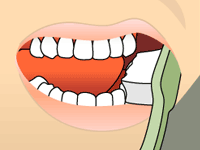
Brushing: Step 1
Place your toothbrush at a 45-degree angle to your gum.
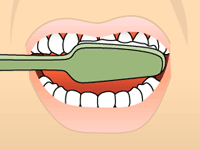
Brushing: Step 2
Brush gently in a circular motion.
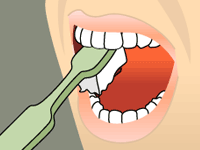
Brushing: Step 3
Brush the outer, inner, and chewing surfaces of each tooth.
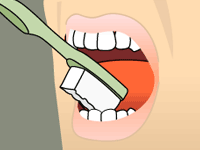
Brushing: Step 4
Use the tip of your brush for the inner surface of your front teeth.
- Flossing Instructions
-
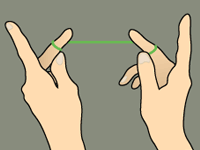
Flossing: Step 1
Wind about 18 inches of floss around your fingers as shown. Most of it should be wrapped around one finger, and the other finger takes it up as the floss is used.
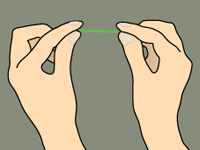
Flossing: Step 2
Use your thumbs and forefingers to guide about one inch of floss between your teeth.
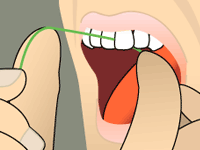
Flossing: Step 3
Holding the floss tightly, gently saw it between your teeth. Then curve the floss into a C-shape against one tooth and gently slide it beneath your gums.
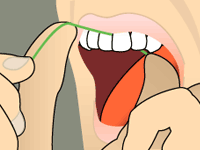
Flossing: Step 4
Slide the floss up and down, repeating for each tooth.
Nutrition and Oral Health
If it’s been six months or more since your child’s last dental checkup, then it’s time to contact our practice and schedule an appointment!
Establishing good nutritional habits for your child can be especially beneficial to promote good eating patterns and food choices for the rest of their life. Think of your child’s mouth as the doorway to the rest of the body. Whatever gets consumed not only affects your child’s growth, development, weight, and energy levels, but oral health, as well. Eating a nutritious, balanced diet is vital for the development of strong, healthy teeth.
General Tips for a Healthy Diet and a Healthy Mouth
- Limit your child’s consumption of sugary foods and beverages. When plaque combines with the sugars and starches, an acid is produced that attacks enamel on the teeth and eventually causes decay.
- Make sure your child’s diet includes a balance of fruits and vegetables, whole grains, protein, and dairy products. The nutrients found in these foods are important to their growth and health.
- Look for sugar in unexpected places. Many foods that make up a balanced, healthy diet contain sugar — including fruit, some vegetables, and milk. The best time to eat these is during meal time, not as a snack.
- Speaking of snacks, limit your child’s snacking to only a few per day, and make sure they’re nutritious!
- Fun foods, like candy and starchy snacks, should be reserved for special occasions, not everyday snacking.
- When they are old enough, let your child chew sugar-free gum that carries the ADA seal. Chewing sugar-free gum increases saliva flow, which washes away food debris and neutralizes acids produced by bacteria.
- Ensure your child brushes twice a day and flosses to eliminate food debris that leads to harmful plaque and bacteria, and causes tooth decay.
A child’s first visit to the dentist should be enjoyable. Children are not born with a natural fear of the dentist, but they can fear the unknown. Our office makes a special effort to use pleasant, non-frightening, simple words to describe each treatment. We want you and your child to feel at ease from the moment your family arrives at our office.
Getting to know your teeth is fun!
Download our Dynamite Dental Fun Kit!
When new teeth arrive
Your child’s first primary, or “baby,” teeth will begin to erupt between the ages of six to 12 months and will continue to erupt until about age three. During this time, your child’s gums may feel tender and sore. To help alleviate this discomfort, we recommend that you soothe the gums by rubbing a clean finger or a cool, wet cloth across them. You may also choose to make use of a teething ring.
Your child’s primary teeth are shed at various times throughout childhood. Permanent teeth begin erupting at age six, and continue until age 21. Adults have 28 permanent teeth (32, teeth including wisdom teeth).
Adopting healthy oral hygiene habits
As your child’s teeth erupt, be sure to examine them every two weeks, looking for lines and discoloration that may be caused by decay. Remember that sugary foods and liquids can attack a new tooth, so take care that your child brushes their teeth after feeding or eating. We recommend brushing two times a day for optimal oral hygiene.
Brushing can be fun, and your child should brush as soon as the first tooth arrives. When a baby’s tooth erupts, parents should brush the tooth with a soft-bristled toothbrush and a tiny amount of fluoridated toothpaste (the size of a grain of rice). For children younger than two, do not use fluoride toothpaste unless advised to do so by your dentist or other healthcare professional. We suggest reviewing proper tooth brushing procedures with your child.
Flossing is also a part of good oral hygiene habits, and your dentist will discuss with you the right time to start flossing your child’s teeth. If you notice signs of decay, contact your dentist immediately.









